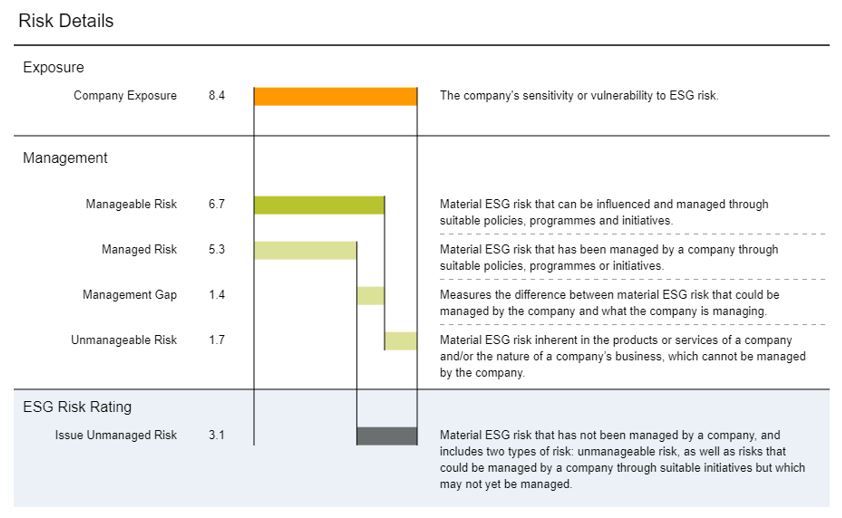In this article we explore how operating in Peru affects the world’s second largest mining producer of precious metals, Barrick Gold. Based on analysis from our recently launched Country Risk Ratings, we discuss how the challenges facing Barrick’s mining operations in Peru are strongly influenced by the country’s ESG risks.
Peru’s mining industry has been vital to the country’s economic growth. According to the International Trade Administration, Peru is one of the world’s top ten richest countries in minerals and one of the biggest producers of base and precious metals. Chart 1 below shows Peru’s natural capital per capita from 1995 to 2014 (World Bank’s most current year available). Between 2005 to 2014, the per capita natural capital of minerals in Peru grew nearly tenfold. As such, it is imperative for Peru to manage these mineral assets given the large impact to its economic development.
Chart 1: Peruvian Per Capita Natural Capital Growth

By leveraging country-level ESG indicator scores provided by Sustainalytics’ Country Risk Ratings as well as company-level material ESG issues (MEIs), we can make a connection between a country’s ESG risks and companies operating in that country. In this case, we examine Peru’s ESG risks and their effect on Barrick’s Lagunas Norte mine in Peru. We focused on three MEIs – Resource Use, Human Capital and Community Relations, which are crucial to the ESG risk profile of precious metals companies and the gold sub-industry. Given that Country Risk Ratings use ESG indicators as inputs, we mapped a subset of ESG indicators to these three MEIs. Table 1 below shows the MEI-to-ESG indicator mapping.
| Material ESG Issues | ESG Indicators | |
| ESG Risk Ratings | Country Risk Ratings | |
| Resource Use | Water Risk Management, Water Intensity, Resource Use Management | Water Productivity, Water Stress |
| Community Relations | Political Rights, Rule of Law | |
| Human Capital | Human Capital Management, Human Capital Development, Working Conditions Policy | Access to Water, Access to Sanitation, Air Pollution |
Table 1: ESG Indicators mapped to ESG Risk Ratings MEIs
In addition to using Country Risk Ratings’ ESG indicators, we also included ESG indicators from Sustainalytics’ ESG Risk Ratings, our solution for assessing company ESG risks, to provide supplementary data to further support our analysis involving Barrick’s mine operations in Peru.
Resource Use
Within our Country Risk Ratings, Water Stress and Water Productivity are mapped to Resource Use. Regarding Water Stress, Peru is well above average (62 /100), ranking 33rd globally, but Water Productivity is below average (40/100) and ranks 105th overall.[i]
Water is a critical input for mining, second only to land access. Mining companies use water in mineral processing, suppressing dust, and for heating and cooling. Water is also a solvent for chemical reagents that are used to separate target metals, such as gold, from ore. Many of the world’s most popular mining jurisdictions face high levels of water scarcity, and this is especially true for Peru. Concerns over water resources and availability are one of the leading causes of community opposition to mining. Even when community opposition is not apparent, regulators may decline water permits in areas at risk of water scarcity.
Barrick’s exposure to Resource Use issues is high and on par with the sub-industry average, but the company outperforms its peers in managing its Resource Use risks, especially as it pertains to water stressed regions. Water scarcity at any point in a mine’s lifecycle can force companies to cut back production, however, recycling offers a solution.
Barrick has pledged to use 84% recycled/re-used water in stressed areas and in 2018 Barrick provided potable water to 52 Peruvian families. Initiatives such as these resulted in perfect scores for Barrick on the Water Intensity and Water Risk Management indicators. Barrick has a strong Resource Use management score (79/100) which resulted in reducing the company’s overall resource use risk to low. While Peru performs poorly in managing its water production, Barrick is trying to be resourceful in recycling water to assist in its risk mitigation efforts.
Community Relations
Community Relations poses material ESG risk to mining companies. Mining’s significant negative environmental impact also raises social concerns. For example, gold mining’s use of cyanide poses water and soil contamination risks. Barrick’s Latin America presence (43% of FY2017 assets) including Peru, exposes it to conflict with local communities increasingly opposed to mine expansions due to water resource availability and safety concerns. The company’s exposure to Community Relations issues is high and moderately above the sub-industry average. These company-community relations will be exacerbated as Barrick evaluates the Laguna Norte mine for a possible 20-year lease extension.
A lot of the Community Relations issues stem from the relationship between the Peruvian government and Indigenous communities. The Peruvian Prior Consultation Law states that Indigenous people must be consulted when any decision, legislative or administrative, affects them directly. Conflict arises because the law obligates the government to consult the Indigenous people, however, they are often not consulted before concession rights are granted. This action by the government corresponds to Peru’s Political Rights score of 57/100, ranking at 66th, and Rule of Law score of 44/100, ranking 104th. These ESG indicators capture the degree Peru’s population participates in a fair political process and has access to an equitable legal system.
Despite Peru’s poor management of community relations, Barrick has made efforts towards addressing conflict with communities living near the Lagunas Norte mine by leveraging a community relations team with expertise in anthropology and conflict mediation.
Human Capital
In 2016, Barrick conducted a Human Rights Assessment for its Lagunas Norte mine. The summary findings, included in the company’s 2017 Human Rights Report, were that the mining operation’s potential indirect impacts could result in the promotion of unsafe working and living conditions as well as child labor. Barrick is working to encourage miners, through the support of the local community, to follow Peruvian legislation that outlaws child labor. As such, Barrick performs well on Human Capital Management (64/100), which is driven by Working Conditions Policy (100/100) and Human Capital Development (75/100). This results in Barrick’s high Human Capital peer ranking – 5th in the precious metals industry and 3rd in the gold sub-industry.
Despite Barrick’s good performance, the unsafe working and living conditions at Lagunas Norte are influenced by Peru’s ESG risks. Peru’s overall Human Capital ESG score ranks 72nd globally, barely above average. The Human Capital ESG Factors score measures how well a country manages its Human Capital. Three of the ESG indicators factored into this score are Access to Water (49/100), Access to Sanitation (52/100) and Air Pollution (53/100), where Peru is clearly underperforming as it ranks 120th, 103rd and 95th, respectively. This suggests that while Barrick tries to manage its human capital-related risks, success in this regard is confined by Peru’s inability to effectively manage these ESG risks well.
Country ESG Risks can Hinder a Company’s Success
Even in cases where Barrick focuses on mitigating material ESG risks such as Human Capital, Resource Use and Community Relations, its operations are deeply affected by Peru’s ESG risks. Incorporating country risks into the analysis when assessing a company’s ESG risks is crucial. Using country risk information when analyzing a company’s credit risk profile can add an additional dimension that may otherwise be overlooked. How well, or poorly, a country manages its own ESG risks can materially affect the companies operating in the country and can limit their potential success.
[i] ESG indicator scores range from 0-100, where 50 is average and the higher scores are better.






